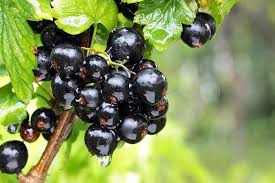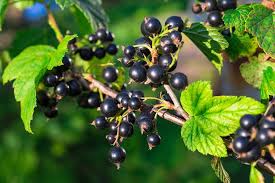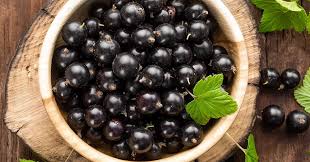Blackcurrants, scientifically known as Ribes nigrum, are vibrant and nutritious berries that belong to the Grossulariaceae family. These small, dark purple fruits are not only delicious but also pack a punch in terms of health benefits.
With a rich history dating back centuries, blackcurrants have been cultivated for their flavorful taste and medicinal properties. These berries are a powerhouse of essential nutrients, including vitamin C, vitamin K, and various antioxidants. Their tangy and slightly sweet flavor makes them a popular choice for jams, jellies, and desserts.
In addition to their delightful taste, blackcurrants are recognized for their potential health-promoting properties. The high vitamin C content in these berries contributes to a robust immune system, aiding in the body’s defense against infections and illnesses. Moreover, blackcurrants contain anthocyanins, compounds known for their antioxidant properties, which may help protect cells from oxidative stress.
The versatile nature of blackcurrants extends beyond culinary use and health benefits. These berries find applications in the cosmetic and skincare industry due to their antioxidant-rich composition. Extracts from blackcurrants are often incorporated into products to promote skin health and combat signs of aging.
Globally, blackcurrants are cultivated in various climates, thriving in temperate regions. The cultivation of these berries involves careful attention to soil conditions, sunlight, and water requirements. Harvesting is typically done in the summer months when the berries reach their peak ripeness, offering the best flavor and nutritional content.
Despite their numerous merits, it’s worth noting that blackcurrants may not be everyone’s favorite due to their intense flavor. However, the distinctive taste adds character to a variety of culinary creations, from pies to beverages. The versatility of blackcurrants allows them to be enjoyed fresh, frozen, or processed into various products, ensuring their accessibility year-round.
In addition, blackcurrants are more than just berries – they are a treasure trove of taste and health benefits. From boosting the immune system to contributing to skincare, these little purple gems have carved a niche for themselves in the world of nutrition and well-being. Whether enjoyed as a snack, part of a delicious recipe, or as an ingredient in beauty products, blackcurrants continue to leave a lasting impression on those who savor their unique qualities.
Read Also: Required Husbandry Skills of Rabbit Production
History of Blackcurrants

The history of blackcurrants traces back centuries, with roots embedded in Europe and Asia. These small, dark berries have a rich cultural and culinary heritage that has evolved over time.
Blackcurrants were likely first cultivated in Northern Europe, with records suggesting their presence in monastic gardens during the medieval period. Initially known for their medicinal properties, these berries gained popularity for their distinct flavor, which led to their incorporation into various recipes.
By the 17th century, blackcurrants had established themselves as a staple in European gardens and kitchens. Their versatility made them a favorite for jams, jellies, and desserts. The fruit’s unique taste also found its way into beverages, including cordials and liqueurs. Blackcurrant-flavored products became synonymous with certain regions, contributing to the cultural identity of those areas.
In the 19th century, blackcurrants made their way to North America, where they adapted well to the climate of certain regions. However, concerns about the spread of a plant disease called white pine blister rust led to restrictions on blackcurrant cultivation in the United States during the early 20th century. This setback limited the popularity of blackcurrants in the country for several decades.
Despite challenges in some regions, blackcurrants remained a beloved fruit in Europe and other parts of the world. Their nutritional value became increasingly recognized, especially during times of war when vitamin C-rich foods were sought after to prevent scurvy.
In the latter half of the 20th century, the ban on blackcurrant cultivation in the United States was lifted, allowing for a resurgence of interest in these berries. As awareness of their health benefits grew, blackcurrants regained popularity not only as a tasty addition to various dishes but also for their potential medicinal and nutritional contributions.
Today, blackcurrants continue to be cultivated globally, with an appreciation for their unique flavor and nutritional profile. Their journey through history reflects the evolving roles these berries have played in different cultures – from medicinal use to culinary delight and nutritional powerhouse. As blackcurrants persist in leaving their mark on various aspects of human life, their history continues to unfold, shaped by the changing tastes and needs of generations past and present.
The Nutritional Value of Blackcurrants

Blackcurrants are a nutritional powerhouse, offering a range of essential nutrients that contribute to overall health and well-being. These small, dark berries are packed with vitamins, minerals, and antioxidants.
One notable nutrient in blackcurrants is vitamin C. These berries are exceptionally high in vitamin C, which is crucial for supporting the immune system, promoting healthy skin, and aiding in the absorption of iron from plant-based foods. The antioxidant properties of vitamin C also help protect cells from oxidative stress.
In addition to vitamin C, blackcurrants provide a good amount of vitamin K. Vitamin K is essential for blood clotting and bone health. It plays a vital role in maintaining bone density and preventing excessive bleeding.
Blackcurrants are also rich in anthocyanins, the compounds responsible for their dark purple color. Anthocyanins are powerful antioxidants that may help protect cells from damage caused by free radicals. These antioxidants have been associated with various health benefits, including anti-inflammatory effects.
Furthermore, blackcurrants contain a range of other vitamins and minerals, including vitamin A, B vitamins (such as B1, B5, and B6), potassium, and manganese. These nutrients contribute to various bodily functions, including vision, energy metabolism, and electrolyte balance.
The high fiber content in blackcurrants is noteworthy for promoting digestive health. Dietary fiber supports regular bowel movements, helps prevent constipation, and contributes to a healthy gut microbiome.
While blackcurrants are relatively low in calories, their nutrient density makes them a valuable addition to a balanced diet. Whether consumed fresh, frozen, or in processed forms like jams and juices, blackcurrants offer a flavorful and nutritious boost.
Additionally, blackcurrants stand out as a nutritional powerhouse, providing a diverse array of vitamins, minerals, and antioxidants. Whether enjoyed on their own or incorporated into various culinary creations, these berries contribute not only to taste but also to the overall health and vitality of those who savor their unique and vibrant goodness.
Read Also: Rabbit Record Keeping and Analysis
Health Benefits of Blackcurrants

Blackcurrants offer a plethora of health benefits, making them a valuable addition to a well-balanced diet. Here are some of the notable health advantages associated with consuming blackcurrants:
1. Immune System Support: Blackcurrants are exceptionally rich in vitamin C, a potent antioxidant known for its immune-boosting properties. Regular consumption may help strengthen the immune system, aiding the body’s defense against infections and illnesses.
2. Antioxidant Protection: The presence of anthocyanins in blackcurrants contributes to their deep purple color and provides powerful antioxidant effects. These antioxidants help neutralize free radicals in the body, potentially reducing oxidative stress and inflammation.
3. Heart Health: The combination of antioxidants and fiber in blackcurrants may contribute to heart health. Antioxidants may help lower the risk of cardiovascular diseases by reducing inflammation and improving blood vessel function, while fiber promotes healthy cholesterol levels.
4. Eye Health: Blackcurrants contain vitamin A, which is essential for maintaining healthy vision. Consuming foods rich in vitamin A, such as blackcurrants, may contribute to eye health and help prevent age-related macular degeneration.
5. Bone Health: The presence of vitamin K in blackcurrants is beneficial for bone health. Vitamin K plays a crucial role in bone metabolism and helps in maintaining bone density, reducing the risk of fractures and osteoporosis.
6. Digestive Health: The dietary fiber content in blackcurrants supports digestive health by promoting regular bowel movements, preventing constipation, and fostering a healthy gut microbiome.
7. Anti-Inflammatory Effects: Some studies suggest that the antioxidants in blackcurrants may have anti-inflammatory effects, potentially helping alleviate conditions associated with chronic inflammation.
8. Cognitive Function: The antioxidants in blackcurrants may have neuroprotective effects, potentially supporting cognitive function and reducing the risk of age-related cognitive decline.
9. Skin Health: The vitamin C content in blackcurrants contributes to collagen synthesis, promoting healthy skin. Additionally, the antioxidants in these berries may help protect the skin from oxidative stress and premature aging.
10. Blood Pressure Regulation: The potassium content in blackcurrants may contribute to regulating blood pressure, supporting cardiovascular health.
Incorporating blackcurrants into your diet, whether fresh, frozen, or in various culinary creations, can be a flavorful way to harness these health benefits and enjoy the nutritional advantages these berries have to offer.
How to Grow Blackcurrants (Growing Guide)
Growing blackcurrants can be a rewarding endeavor, and with the right care, you can enjoy a bountiful harvest of these nutritious berries. Here’s a basic guide on how to grow blackcurrants:
1. Planting: Choose a sunny location with well-drained soil. Blackcurrants prefer slightly acidic to neutral soil pH. Plant blackcurrant bushes in late autumn or early spring while they are dormant. Space the bushes at least 3 to 4 feet apart to allow for proper air circulation.
2. Soil Preparation: Prepare the soil by adding organic matter, such as compost, to improve fertility and drainage. Mulch around the plants to retain moisture and suppress weeds.
3. Watering: Keep the soil consistently moist, especially during dry spells. Water at the base of the plants to avoid wetting the foliage, which can reduce the risk of diseases.
4. Pruning: Prune blackcurrant bushes in late winter or early spring to encourage a healthy shape and maximize fruit production. Remove any dead or weak wood, and thin out crowded branches to improve air circulation. Shorten lateral shoots to stimulate new growth and fruiting.
5. Fertilizing: Apply a balanced fertilizer in spring as new growth begins. Avoid over-fertilizing, as blackcurrants can be sensitive to excessive nitrogen.
6. Pest and Disease Management: Keep an eye out for pests such as aphids and caterpillars. Insecticidal soap or neem oil can be used for control. Address any signs of powdery mildew or other diseases promptly. Proper spacing and pruning help reduce the risk of fungal issues.
7. Harvesting: Harvest blackcurrants in mid-summer when the berries are fully ripe and easily detach from the stem. Pick the berries regularly to encourage continued fruiting.
8. Storage: Use harvested blackcurrants fresh, or freeze them for later use. They can be stored in the freezer for several months.
9. Winter Care: Protect young plants from harsh winter conditions by mulching around the base. Remove any dead or weak wood during winter pruning.
10. Propagation: Blackcurrants can be propagated through hardwood cuttings in late autumn or winter. Plant these cuttings in a nursery bed until they establish roots.
Read Also: How to Build a Raised Bed Garden
